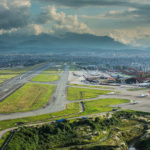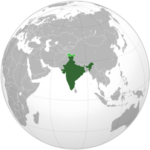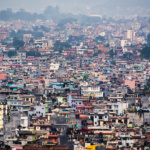by Rupert Wolfe Murray
Flying in from the Middle East. Glimpses of the Himalayas, a high barrier of mountain that I can see out of the left hand side window. I can’t see out of the right hand side windows but I know the land flattens out and is covered with a brown haze. Kathmandu, they say, is one of the most polluted cities in the world.
The plane lands. Will there be one of those big sausage things that connects to the plane and enables us to walk straight into the airport building, as if there is no outside? No, Kathmandu Airport seems rather old-fashioned and has not invested in the sausage things.
We board an old bus and get a whiff of the city – unfamiliar smells. The air is warm, but not as hot as it would be in India, which is just down the road. Kathmandu is quite high, over a thousand metres above sea level, and this means that it’s a lot cooler than India.

Impressions of Kathmandu airport: clean floors, well-worn bannisters and décor, old paintwork, poor lighting, adverts for Indian and Chinese things, a chaotic feeling, small-looking people in national costumes (white cotton smocks), an ancient baggage carousel, crowds of people trying to work out how to apply for a visa (you have to fill in two forms by hand, then pay $100). Getting a visa for Nepal is a bit fiddly but it’s a lot cheaper and quicker than getting one for India, so I was grateful.
A friendly man in uniform stamps my passport and when I pass through customs another man checks my baggage stickers to make sure I hadn’t stolen someone else’s rucksack. I’m impressed with this, it’s considerate (it would be easy to steal someone else’s bag) and they don’t do it in the west anymore.
I had told my brother Magnus, who lives in Kathmandu and works on disaster relief, not to meet me at the airport. I don’t want to waste his time and I also find the experience of getting into town a valuable chance to form some first impressions.
First things first: change some money and get a taxi. The money exchange booths look small, informal and scruffy. Can they be trusted? Do I have a choice? As I was pondering, a group of young Nepali men thrust pass me and hand the youth behind the counter a handful of notes. They talk loud and fast, I understand nothing but there I feel no animosity from them. I pull out 40 euro, hold it in my hand and soon enough I’m handed a bunch of Nepali rupees.
Next to the money changer is a Taxi Booth. Simply by looking at the man prompts him into speech:
– You want taxi? Where you go?
– Er… I’m going to Patan…Kathmandu.
– Very good. 800 rupees, Take ticket. Come with me.
It all happens too fast and my mind can’t keep up. It’s as if I left my consciousness back in Scotland. I’m so busy processing all the sights, sounds and smells that I can’t seem to move normally. I just want to stand still and absorb this new world. How much is 800 rupees? It takes me an age to work out that it’s about 8 Euros. Is that all?
The Taxi Booth man is middle aged and small. He wears a suit and looks like a minor government official. He’s in a hurry and he hustles me outside the building and into a traffic jam. He’s friendly enough but I feel I am being gently herded outside, like a dog that has inadvertently wandered inside.
Scores of small, beaten-up cars are crushed up together forming a disorderly line of taxis. The drivers stand by a truck which had blocked the exit, shouting. There is a crowd of passengers, milling around, and a sense of mayhem and confusion, so different from western airports where both passengers and taxis form orderly queues.
I am disorientated by the chaos and unsure how to navigate, but it was a pleasant feeling and I relished all the differences: how the people mill around in what seems like chaos but it’s just their way of doing things; the strange smells that include traces of dust, petrol and incense; and the constant racket of cars, horns and people shouting.
Memories of India

When I first came to India in 1984 I felt like I had come home, and this time I have similar feelings. Was this because my ancestors had lived in India for hundreds of years, as colonial army officers? I prefer oriental chaos to the controlled calm of Britain, a country that has been de-personalised by Health and Safety and other rules that supposedly make our lives safer.
These impressions are fleeting and I’m still standing outside the airport, feeling lost and carrying a big rucksack. How do I find my taxi?
There is no time to think. The man from the Taxi Booth is outside too and he commands me to get into the second car, as he shouts at the driver. Several men move towards me and take my rucksack. I realise they were kindly helping me get it into the boot of the small Suzuki car, and I let them, but if I had been a more suspicious person I could have assumed they were trying to rob me. I tend to trust people when travelling and this makes situations like this both easy and interesting, but if I wasn’t a trusting person I’m sure these situations would be stressful. In fact, I’m sure that a lot of westerners find places like Nepal and India quite awful.
Cars in Nepal are like old shoes – scuffed, battered and falling apart at the seams. My taxi is covered in dents, scratches and chips and so is every other car I glance at. It sways from side to side, more like a boat than a car, and I know this is a sign of dodgy suspension (not surprising considering how many potholes we there are).
This type of banger is ideal for the circumstances. It is the occasional new car – big, shiny and alien looking – that seems out of place. The buses are small minibuses with wide open doors and big roof racks. Each minibus has a young conductor who hangs off the side of the door, jumps out at each stop, shouts the name of the destination and pushes more people into what is already an impossibly crowded space.
The traffic is like a torrent and we plunge in, like a fish diving down a waterfall. At first sight the traffic looks like total mayhem – no traffic lights, no lanes, a constant noise of a hundred horns blaring at once, clouds of dust, motorbikes everywhere, people and cows wandering along the side without a care in the world. Will we get into town? How do the Nepalese navigate such chaos?
Many years ago I worked on a building site in Edinburgh. The boss was a gruff, bearded fellow called Grant Boutchard who told me about the traffic in Lebanon: “it’s not like the traffic here laddie! Nobody gives a hoot about what’s behind them. All their attention is focused on what’s in front.”
Remembering these words helps me understand how the traffic works in Kathmandu. As I look out of the windows I realise there is a system to this oriental traffic chaos, there is method in the madness. Although there are no traffic lanes, no white lines, the one rule that brings a sort of order to things is the fact that everyone drives on the left. And within the flow of traffic I can see that fast motorbikes stray into the middle of the road, risking collision with oncoming traffic, in order to overtake, while the cars and buses and trucks and small motorbikes stay in the middle. It all moves rather slowly and there is a lot of dust and exhaust fumes. On the left hand side of the road is a kind of slow lane where vehicles stop, people walk and bicycles toddle along.

The main difference with western traffic systems is the fact that here, and I presume across the Middle East and South Asia, drivers don’t seem to indicate. They just pull over, change lanes or turn off. At first I can’t understand why cars don’t crash into each other constantly, but they don’t and I read somewhere that accidents are rare. How is this possible? The answer must be that everyone is looking ahead of them, ready to react to anyone changing direction. I don’t really understand how, but this traffic system does actually work, it is a mystery. As soon as I realise that I’m not going to die I start to appreciate it. Going through this traffic is like being in a video game.
Another first impression is the buildings of Kathmandu. When I was last here in 1987 there weren’t many new buildings; it seemed like an ancient place with wonderful old buildings. But modern capitalism has caught up with them and shoddy-looking, garish blocks have popped up everywhere. The impression is that anyone with a bit of cash can throw up whatever monstrosity they like; judging by the higgledy-piggledy mess of construction that I see, there is no planning permission required. Hopefully some of the ancient buildings in the old city centre have survived the earthquake and the developers.
Getting back to Kathmandu is a joy. I feel quite at home in this chaos and look forward to getting to know this mysterious city again.
- 1917 (2019) - 11th January 2020
- The Shakespeare Soap Opera - 10th June 2016
- On the Road with Madame Bovary - 4th April 2016










